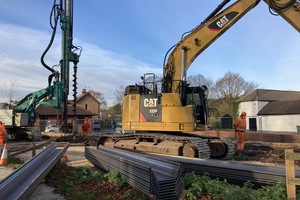Work underway to repair damaged flood defence in Lowdham
A major project is underway by the Environment Agency to repair a flood wall in Lowdham, Nottinghamshire, to protect homes and businesses from the devastating impacts of flooding.

Repairs to flood defences in Lowdham are underway
- Environment Agency carrying out repairs to flood storage area in Lowdham, Nottinghamshire
- Work due to be completed by January 2022
- Further work will continue in the new year to reinstate gardens and recreation area
A 200-metre wall, which stands along part of the Cocker Beck next to the cricket pitch in the centre of the village, is part of a flood storage area which holds excess water during times of heavy rainfall.
After being severely tested during several periods of flooding over the past 20 years ago, the defence had deteriorated. The Environment Agency is now rebuilding the defence and driving more robust materials deep into the ground along this length of the Beck.
East Midlands Area Operations Manager for the Environment Agency, Alan Walters, said:
We are very pleased to have started work on-site to help the residents and businesses of Lowdham. We are using a new steel piled defence will be stronger and more robust than the previous plastic piled wall. As well as reducing flood risk now, the work will help reduce the impacts of climate change as more extreme rainfall is predicted.
It has been a real challenge to get this project to site and we thank the community for their continued patience and understanding regarding the disruption that comes with delivering these critical works.
Work began in September to remove vegetation to create access to the site and to build a temporary defence while the work is completed. Temporary pumps have also been installed to manage high water flows while the work is happening. Work on the new steel piled wall itself started in November, and will be completed by January.
Further work will continue in the new year to reinstate gardens and the village’s recreation area.
The village green, which hosts football and cricket pitches in the centre of the village, is designed to flood, and is a ‘flood water storage area’. By keeping flood water here, risk of flooding for homes and businesses is reduced.
Work is also underway to further improve flood protection in Lowdham thanks to a £5 million funding boost in July 2020 as part of Government investment of £170 million for ‘shovel ready’ flood defence projects.
The preferred option for the scheme is to store water in a new meadow upstream of the village. The meadow would be a dry reservoir, remaining dry for the majority of the year and fill only when flooding would normally occur.
Notes to editors
-
Lowdham is a village to the east of Nottingham, with a population of over 3,000 people. Through the centre runs the Environment Agency managed section of the Cocker Beck that flows as a tributary of the much larger River Trent. The village has a history of flooding as a result of extreme rainfall.
-
Narrow points in the Cocker Beck under some of the bridges in the village constrict the flow of water during high river levels and cause it to spill out of bank, leading to property and infrastructure flooding.
-
The village green was developed as a flood protection method after flooding in 1999.
-
Work to construct a £60,000 Natural Flood Management (NFM) scheme (funded as part of the Environment Agency’s £15 million NFM Programme), started in winter 2018, including leaky barriers, earth bunds and ponds. These natural measures aim to slow and store water flood water on agricultural land before it enters the Cocker Beck. This aims to compliment the use of more traditional engineering solutions, such as flood walls further downstream to help reduce flood risk to local communities. The project is being delivered in partnership with Trent Rivers Trust and Nottinghamshire County Council.